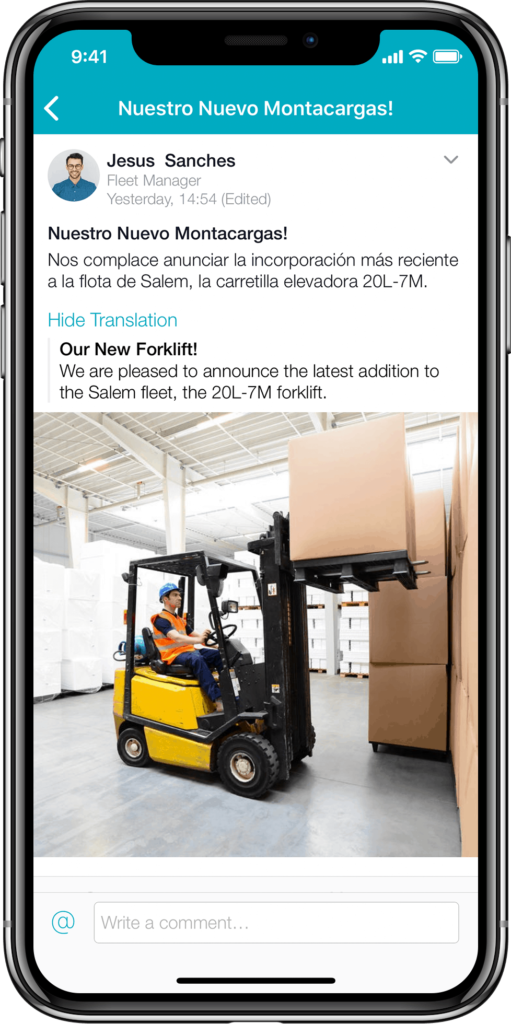12 Easy Ways to Improve Manufacturing Communications

In factories, production is the number one priority, so it isn’t a surprise that manufacturing communications are not on the radar of most manufacturers.
However, a recent survey by Forrester found that 75% of manufacturing delays occur because employees are unable to communicate with co-workers or their supervisors. Yet, 71% of frontline workers say updated communication tools increase their productivity.
A digital workplace can improve the bottom line by 10% or more by facilitating timely communication between the head office, team leads, and frontline workers.
With plenty of production gains out there for the taking, let’s look at a few ways you can improve production communication and provide internal communication support your factory workers need.
12 Ways To Provide The Internal Communications Factory Workers Need
Providing factory workers with the tools and information they require to do their jobs effectively can go along way towards improving communication, operational efficiency, workplace safety practices, and employee engagement with team members that are traditionally overlooked. Not to mention, an engaged and informed frontline positively impacts financial performance.
Here are 12 ways you can enhance effective communication in manufacturing between your organization and frontline employees and ultimately, boost your returns.
1. Use Real-Time Modes of Communication
When things go wrong, employees and managers need dependable modes of effective communication to solve problems quickly. Face-to-face communication isn’t always possible, email service can go out, and call trees are now a relic of the past. Instead, more companies nowadays rely on call centers and UCaaS solutions for communications.
With mobile technology like employee communication apps, you can ensure your workers and managers can communicate with the necessary personnel. Employee communication apps like Beekeeper include features that keep everyone in the loop when it is needed the most, like:
- Mobile notifications
- 1:1 and group messaging
- News streams
- Safety campaigns
- FAQs

In the rare event a mobile network fails, employees can download essential troubleshooting documents to their phones, so they always know what the next step is.
2. Better Training Equals Effective Communication
Better training doesn’t have to mean more training. Time is of the essence on any factory floor, and spending weeks training workers isn’t always feasible to provide effective communication.
One way to drastically start improving communication during the onboarding process, and production floor communication with it, is to assign every new hire a training buddy to show them the ropes. Training buddies can fill the gaps in traditional training protocols and decrease turnover because new employees are immediately immersed in your factory’s culture.
3. Get Insight From the Floor
The workers in a factory know when something goes bad before anyone else. They see the machinery that is acting up, and where the slack is in production. The collective wisdom of your workers is more than any one production manager. Get the most out of your workers focusing relentlessly on getting feedback from them.
Whether it’s running monthly open-floor meetings, conducting surveys, or incentivizing employees to speak up with contests or bonuses, managers have an obligation to know what the important issues are from those who know best.

4. Keep Employees in The Know
Have you heard that your production floor employees get too much company information? It’s likely that you haven’t if you’re still distributing communications through one-way channels like a newsletter, bulletin board, or email.
When employees have access to real-time, essential company information, they are better equipped to do their jobs and engage with their team members working towards a collective goal. A mobile-first effective communication strategy built with the frontlines in mind is a simple way to make sure employees have the information they need when they need it.
Mobile communication is particularly important in times of crisis. For example, IRP Meat and Seafood Co. relied heavily on its employee communication app to communicate with employees during the COVID-19 pandemic. Not only was the digital platform useful in relaying communications factory employees needed at the onset, but it also served as a unified messaging system when bringing furloughed employees back to work.
According to Blair Hinderliter, Chief of Staff at IRP Meat and Seafood Co.:
I was able to bring back most of our staff fairly quickly and I did that through Beekeeper. It was definitely my primary source of communication with team members when they weren’t here.”
5. Establish a Two-Way Communication Method Among Team Members
Gone are the days of managers delegating tasks without any room for discussion or follow-up questions. Companies that want to retain their employees and reduce turnover need to establish a method of two-way communication, particularly for a distributed workforce where the majority of employees don’t work behind a desk.
Employee communication channels with access to instant messaging allow employees to reach out to their manager for quick responses or connect one-on-one with their co-workers without having to be in the same physical location as the person on the other end.
6. Make Time For Feedback
Because of the nature of manufacturing employees’ schedules, feedback can fall lower on the priority list. Usually, it is given when a manager and employee are in the same location, but with distributed workforces expanding as a result of COVID-19, feedback schedules need to be replaced with more modern internal communications solutions.
If you’re looking to deliver valuable internal communications that factory workers deserve, making time for feedback is critical.
Providing employees with more frequent feedback helps them know what they should continue to do, and what actions they should stop taking, and, generally, boosts morale and overall productivity.
7. Communicate with Employees in Their Preferred Language
For many companies, one of the biggest struggles with distributing company communications to the factory floor is having the ability to do so in the different languages their employees speak.
With digital tools like employee communication apps, that no longer needs to be a barrier to connecting with your employees.
Beekeeper’s inline translation feature supports over 100 languages, including Spanish, French, German, Chinese, Italian, and Arabic, among others.

8. Recognize Employees Where Everyone Can See
Labor shortages, especially in the wake of a global pandemic, are a long-time stressor in many industries where the majority of employees are on the frontline. As a result, employee recognition programs are now center stage in an effort for companies to boost employee retention, engagement, morale, and even productivity.
However, just like the rest of the industry is moving into the digital age, so should employee recognition channels. Digital employee communication tools are quickly replacing age-old bulletin boards by sending out messages of recognition for employees that all can see.
With mobile technology, you can easily move your birthday or anniversary bulletin online so that employees across the company can see who has a milestone coming up and celebrate with them.
9. Prioritize Health and Safety Updates
Health and safety measures have always been critical factors in manufacturing communication. However, the global COVID-19 pandemic spun those communications on its head by requiring instantaneous delivery of updated health and safety protocols – sometimes with a moment’s notice of walking in the door.
10. Make Factory Employees Part of the Mission
It’s a challenge for any company to connect with employees if they don’t have access to company news, resources, and tools that connect them back to its broader purpose.
When implementing a real-time mobile communication solution for production floor employees, companies are treating employees like the work-family they are.
11. Stress The Importance of Development
Industry 4.0 is here, and it’s estimated that by 2030, 20 million manufacturing industry jobs will be replaced by robots. That’s a sizable chunk of the industry that will change, and with it, will be new jobs that require higher cognitive capabilities and expanded skill sets.
Because people will still be the driving force of the manufacturing industry, now is the time to be having development conversations with production floor employees so they can start training that will well-position them for the direction the industry is headed.
12. Let Employees Know Their Value
Last, but certainly not least, making sure employees are aware of the value they bring to the organization should be a critical pillar of internal communication strategies.
Oftentimes, frontline employees like those on the production floor can have a hard time connecting the dots between their roles and the broader purpose – but with a communications strategy built with them at the forefront, they’ll have everything they need to understand their value and better contribute to the organization as a whole.
There’s no doubt that engineering, operations, and logistics are vital to any efficient manufacturer, but production floor communication is even more important now in a post-COVID-19 environment.
Poor communication can lead to delayed orders, accidents, and employee turnover. If any of these things affect your organization, improved manufacturing communications might be the key to getting things running smoothly again.
Learn how to create effective internal communication on your production floor with our internal communications templates.
Get the Toolkit
Most Frequently Asked Questions
Why is communication important in manufacturing?
In factories, production is the number one priority, so it isn’t a surprise that internal communication on the production floor is not on the radar of most manufacturers. However, a recent survey by Forrester found that 75% of manufacturing delays occur because employees are unable to communicate with co-workers or their supervisors. Yet, 71% of frontline workers say updated communication tools increase their productivity.
What are the 12 ways to enhance production floor communications between your organization and frontline employees?
1. Use Real-Time Modes of Communication
2. Better Training Equals Effective Communication
3. Get Insight From the Floor
4. Keep Employees in The Know
5. Establish a Two-Way Communication Method Among Team Members
6. Make Time For Feedback
7. Communicate with Employees in Their Preferred Language
8. Recognize Employees Where Everyone Can See
9. Prioritize Health and Safety Updates
10. Make Factory Employees Part of the Mission
11. Stress The Importance of Development
12. Let Employees Know Their Value

About the author
Andreas Slotosch
Chief Growth Officer
Andreas is one of the Co-Founders and VP of Growth at Beekeeper. Prior to Beekeeper, he was involved in various web start-ups and worked for several international companies in the area of business development and marketing. Andreas is a graduate of the University of St. Gallen and author of numerous blogs and book contributions on the topic of mobile internal communication and employee engagement.







